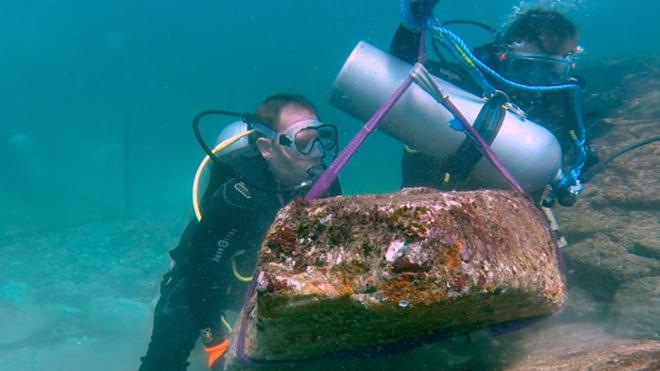Vasco da Gama's Esmeralda found after 500 years
by Nora Rappaport on 5 May 2016

Team members recover a giant concretion to extract the artifacts inside. Nora Rappaport
Legendary explorer, Vasco da Gama, had Esmeralda as part of his fleet and after 500 years lost at sea, the shipwreck has been discovered. A team led by National Geographic grantee and shipwreck hunter David Mearns has excavated the site and recovered the infamous ship’s remarkable treasures.
“This is the earliest pre-colonial shipwreck ever discovered. This is from the European Golden Age of Discovery when Columbus, Magellan, and Vasco da Gama are going around the world,” says Mearns. His company, Blue Water Recoveries Ltd., in collaboration with the Omani Ministry of Heritage and Culture, found the shipwreck off a remote Omani island in the Arabian Peninsula in 1998. After extensive logistical planning, excavation began in 2013. Spending more than 1,000 hours underwater, the team recovered over 2,800 artifacts that help tell the story of this fateful ship’s journey.
“There’s coins, there’s armaments, there’s munitions, there’s personal objects, there’s organic objects. And we’re bringing in archaeologists and other experts to study the entire collection, so it will ultimately be in a museum and displayed for the public in a way where you’re really spelling out the entire history,” Mearns says.
That history is monumental to the beginning of globalization, where East met West for the first time. Vasco da Gama became the first European to reach India by sea, establishing the globally significant trade route Carreira da India, or India Route. The Esmeralda was one of twenty ships in da Gama’s second voyage to India, but this time the fleet was quick to use naval power to force trading relationships. Da Gama would then order his uncle, Vincente Sodré, to take a fleet of ships—including the Esmeralda—to protect Portuguese factories along the Indian coast. Sodré decided to take the squadron to loot Arab ships instead.
Sodré’s squadron ended up on the Omani island of Al Hallaniyah and remained there “for quite a number of weeks, possibly two months, making repairs and things,” Mearns says. “The locals who lived on the island knew the weather patterns and said, ‘Listen, a storm is coming. It’s best that you go to the leeward protected side of the island.’ The Portuguese being quite arrogant said that, ‘You know, we’ve got very strong iron anchors, we’ll be okay.’ And sure enough, the storm came and wrecked this ship and Vincente and all of his crew died.”
The Esmeralda’s colorful history continues to come to life as Mearns’ team pieces together the ship’s story artifact by artifact. This became an urgent story to tell as the once remote region of Al Hallaniyah began experiencing infrastructure development to support tourism. “We could actually see the road being carved through the rocky terrain and explosives were going off as we’re diving. We’re seeing big booms and rocks being thrown everywhere and big clouds of smoke.
This road is ready to be built right to our site. Anybody could drive down and start diving around and take these artifacts,” says Mearns. “That made the decision for us that the excavation had to go ahead. Without having the artifacts together as a coherent collection they start losing their meaning and their importance.”
One such meaningful artifact is a metal disk thought to be part of an age-old navigational device called an astrolabe. “It has the Portuguese coat of arms and an emblem called the esfera armilar, which is the personal emblem of Don Manuel I, the Portuguese king at the time,” Mearns explains. “It is obviously what we’d call a high-status object because it has these two important emblems on it, but its function is not quite clear. These astrolabes are incredibly rare and, to have one from this early period, it would be the first of its type. Exactly what it is, people will ponder it and that will be the fun bit.”
The ship’s bell was also recovered and in remarkably good condition for having been stuck under a boulder in the sea for over five centuries. Believed to be the oldest ship’s bell ever found, it is engraved with the year 1498, which “matched the date that Vasco da Gama found the sea route to India,” Mearns marvels. “I’m not Portuguese, so I can’t speak for the Portuguese people, but I would say that’s probably one of the most important dates in their entire history, 1498. To have that on our bell was just a stunning discovery.”
Coins may be a common object that comes to mind when thinking of shipwrecks, but Mearns’ team found a coin that is anything but common. “One coin in particular, the Indio, was amazing because there’s only one other one in the world. They call it the ghost coin of Don Manuel I,” Mearns says of a coin commissioned by Don Manuel I for trade with India. “They were a terrific discovery and a very powerful dating device.
“To find something, whether it’s 500 years old or 200 years old, that has a great story behind it—that’s what’s really fantastic about the Esmeralda shipwreck. It’s an important period in history. It’s connected with legendary characters like Vasco da Gama and Vicente Sodré, and—let’s be blunt—a brutal period of Portuguese involvement in the Indian Ocean. But that’s also one of the most colorful periods in terms of the history and this ship was at the heart of it.”
To learn more about “Shipwreck Discovered from Explorer Vasco da Gama’s Fleet” click here.
If you want to link to this article then please use this URL: www.sailworldcruising.com/144299